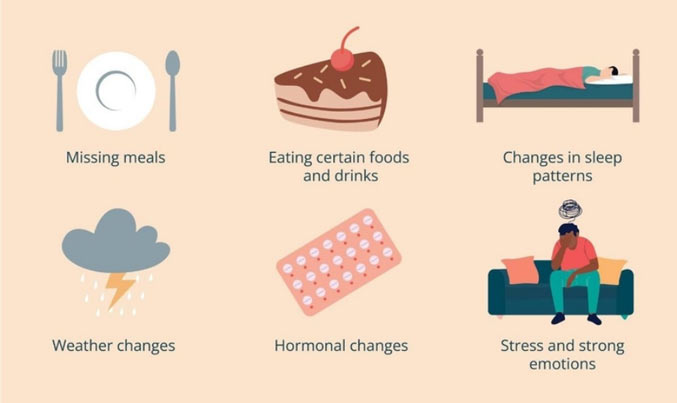A complex neurological condition, migraines extend beyond mere head pain. They present a multifaceted nature that demands recognition of its visual cues and intricacies. This comprehensive guide intends to illuminate these aspects for both sufferers, providing them with understanding, and their supporters who seek effective strategies in managing this phenomenon. Causes, symptoms, and successful management techniques are all areas explored deeply here.
Unraveling the Complexity of Migraines
Not merely severe headaches, migraines represent a neurological disorder. They are characterized by intense and throbbing pain, typically localized on one side of the head. Visual disturbances, known as auras, often precede or accompany the painful phase. These can appear as flashing lights, zigzag lines, or blind spots, thus adding complexity to the experience of an individual suffering from migraines.
Visual Cues of Migraine
Not all individuals experiencing migraines encounter auras. However, for those who do these phenomena serve as invaluable indicators. Auras last anywhere between 20 minutes and an hour. They act like early warnings, alerting the individual to the imminent onset of a migraine.
Offering a diverse range of experiences, these visual disturbances are not uniform. Among the various forms of auras that can occur, Scotomas manifest as blind spots in your field of vision, Photopsias, and fleeting flashes of light. A nuanced approach to managing migraines becomes possible by recognizing and understanding the subtleties within these sensory disruptions.
Diverse Experiences:
It is crucial to understand the variability of auras from person to person. Some may experience visual distortions. Others might encounter sensory disturbances, such as tingling or numbness. This diversity underscores each individual's unique migraine experience.
Customized Management:
Considering the specific type of aura an individual experiences enhances the effectiveness of tailoring strategies for managing migraines. When we recognize these unique visual cues, it enables us to adopt a personalized approach toward prevention and relief.
Causes and Triggers of Migraine
Continuously, research uncovers the intricate connection between genetics and migraines. A family history, for many, serves as a significant factor in predisposing individuals to this neurological condition. With such knowledge at their disposal, individuals can address proactively not reactively their migraines. They implement lifestyle changes, and hone keenly on potential triggers are all steps towards improved self-management of these debilitating headaches.
- Informed Decision-Making:
Empowering individuals to make informed healthcare decisions hinges on their understanding of the genetic link. This comprehension paves the way for a comprehensive management strategy against migraines, incorporating lifestyle modifications and preventive measures.
- Genetic Counseling:
Those with a familial history of migraines can gain additional insights by seeking genetic counseling. Professionals in this specialized field provide necessary guidance. They elucidate risk factors, and potential hereditary patterns, and suggest proactive steps for the effective management of migraines.
- Environmental Triggers:
Beyond genetic factors, a vast array of environmental elements serves as triggers for migraines. Catalysts include stress, inadequate sleep, hormonal fluctuations, and certain foods. We cannot overstate the importance of identifying these triggers. It forms the foundation for personalized management of migraines.

- Holistic Lifestyle Changes:
A holistic approach to lifestyle modifications actively acknowledges environmental triggers. It incorporates stress-reduction techniques, maintains regular sleep patterns, and adopts a balanced diet. These pivotal elements form the basis of this comprehensive strategy.
- Diary Documentation:
A meticulous migraine diary is a practical tool. It aids, not only in identifying patterns but also in recognizing specific triggers unique to each individual. Regular documentation fosters a heightened awareness of factors contributing to migraine occurrences.
Individuals can craft a customized approach to managing their migraines by understanding them as a dynamic interplay between genetic predisposition and environmental triggers. The strategy for mitigating the impact of migraines on daily life takes form through three powerful components which are awareness of genetics, lifestyle adjustments, and identification of triggers, together these elements work harmoniously.
Symptoms and Phases of Migraine
Typically, migraines progress through four distinct phases. Prodrome, aura, headache, and postdrome follow. Each phase introduces its unique set of symptoms and challenges. Individuals as well as healthcare professionals must understand these stages critically to tailor effective treatment plans.
Prodrome:
The prodrome phase is an early warning system that signals the imminent onset of a migraine. Its symptoms, mood changes, food cravings, and increased yawning are subtle cues. Recognizing these allows for timely intervention, potentially reducing the severity of the impending migraine.
Effective Management Strategies - Taking Control of Migraines
- Lifestyle Modifications: Significantly impacting the frequency and intensity of migraines is the result of adopting a healthy lifestyle. Regular exercise, techniques for managing stress, and consistently adhering to sleep patterns all contribute to overall well-being. They also decrease the likelihood of experiencing migraine attacks.
- Medication Options: Individuals must collaborate intimately with their healthcare providers to devise a suitable treatment plan for managing their migraines. This may involve an array of medications, from pain relievers to preventive drugs that are available on the market. The frequency and severity of one's migraines should serve as crucial factors in determining the most effective course of action.

Empowering Through Knowledge - Migraine Support and Resources
- Support Networks: Individuals facing the challenges of living with migraines benefit from connecting with support networks. These may include online communities, local support groups, and educational resources. They can offer a sense of belonging as well as valuable insights into coping strategies.
- Professional Guidance: It is crucial to seek guidance from healthcare professionals specializing in migraine management. Neurologists, headache specialists, and other providers of health care can offer personalized advice and treatment options. These are based on an individual's unique migraine profile.
Conclusion
In conclusion, understanding the visual aspects of migraines is pivotal in navigating the complex landscape of this neurological disorder. From recognizing auras to identifying triggers and implementing effective management strategies, this visual guide aims to empower individuals to take control of their migraines. By fostering a comprehensive approach that combines lifestyle modifications, medication, and support networks, individuals can work towards a holistic and personalized strategy for migraine wellness.







